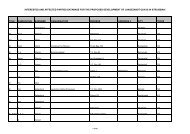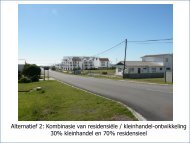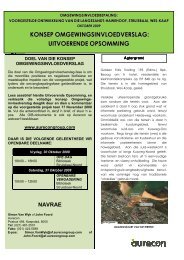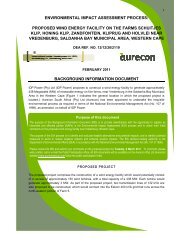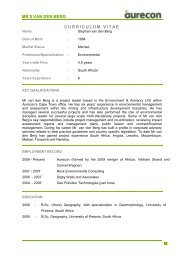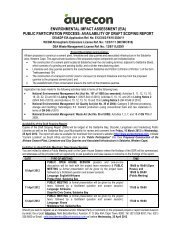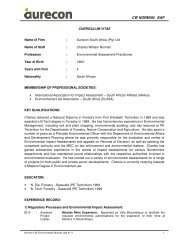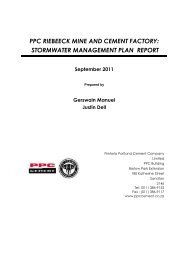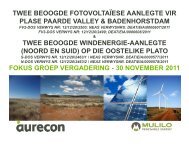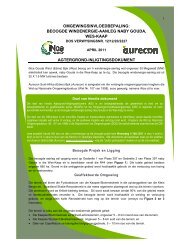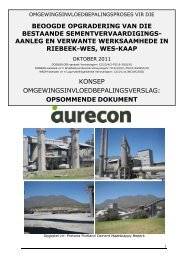Final EIAR - Aurecon AME Environmental | Environmental Projects
Final EIAR - Aurecon AME Environmental | Environmental Projects
Final EIAR - Aurecon AME Environmental | Environmental Projects
Create successful ePaper yourself
Turn your PDF publications into a flip-book with our unique Google optimized e-Paper software.
Proposed Wind and Solar (Photovoltaic) Energy Facilities on Kangnas Farm near Springbok in the Northern Cape: <strong>Final</strong> EIR 26<br />
more sustainable and efficient economy, the creation of local jobs, the demand on scarce<br />
resources such as water and the need to meet nationally appropriate emission targets in line<br />
with global commitments”.<br />
As can be seen by Table 2.3 below the current final IRP provides for an additional 20 409 MW<br />
(shaded in grey) of renewable energy in the electricity mix in South Africa by 2030.<br />
Table 2.3: Policy adjusted scenario of the IRP2010 as gazetted on 6 May 2011<br />
Total generating<br />
capacity in 2030<br />
Capacity added<br />
(including committed)<br />
from 2010-2030<br />
New (uncommitted)<br />
capacity options from<br />
2010-2030<br />
Technology MW % MW % MW %<br />
Coal 41 074 45.9 16 383 29.0 6 250 14.7<br />
OCGT 7 330 8.2 4 930 8.7 3 910 9.2<br />
CCGT 2 370 2.6 2 370 4.2 2 370 5.6<br />
Pumped<br />
Storage<br />
2 912 3.3 1 332 2.4 0 0<br />
Nuclear 11 400 12.7 9 600 17.0 9 600 22.6<br />
Hydro 4 759 5.3 2 659 4.7 2 609 6.1<br />
Wind 9 200 10.3 9 200 16.3 8 400 19.7<br />
CSP 1 200 1.3 1 200 2.1 1 000 2.4<br />
PV 8 400 9.4 8 400 14.9 8 400 19.7<br />
Other 890 1.0 465 0.8 0 0<br />
Total 89 532 100 56 539 100 42 539 100<br />
The final IRP2010 reflects both the consultation process on the draft IRP2010 currently being<br />
undertaken with stakeholders and the further technical work undertaken in this period. It is<br />
noted that “given the rapid changes in generation technologies and pricing, especially for<br />
“clean” energy sources, the IRP will have to be reviewed on a regular basis, for instance every<br />
two years, in order to ensure that South Africa takes advantage of emerging technologies. This<br />
may result in adjustments in the energy mix set out in the balanced revised scenario within the<br />
target for total system capacity.”<br />
2.1.8 Regional Methodology for Wind Energy Site Selection- a DEA&DP<br />
Guideline document (2006)<br />
In May 2006 DEA&DP published the Strategic Initiative to Introduce Commercial Land Based<br />
Wind Energy Development to the Western Cape: Towards a Regional Methodology for Wind<br />
Energy Site Selection. With the aim of paving the way for wind energy as a viable, clean,<br />
renewable energy development in the Western Cape the following vision was developed: “The<br />
vision for the Western Cape is to establish a policy on the implementation of regional criteria for<br />
the identification of areas suitable for the establishment of wind energy projects. This will<br />
promote the implementation of wind energy projects while balancing national interests of<br />
promoting alternative energy generation with local strategic environmental objectives. This will<br />
also avoid conflict between local and national interests through a proactive environmental<br />
planning process.”<br />
Further to the above the Guideline aims to facilitate:<br />
© <strong>Aurecon</strong> (2012) No unauthorised reproduction, copy<br />
or adaptation, in whole or in part, may be made.<br />
P:\<strong>Projects</strong>\108495 Kangnas WEF & PV EIA's\3 Project Delivery\4 Reports\FEIR\FEIR 210213 <strong>Final</strong>.doc


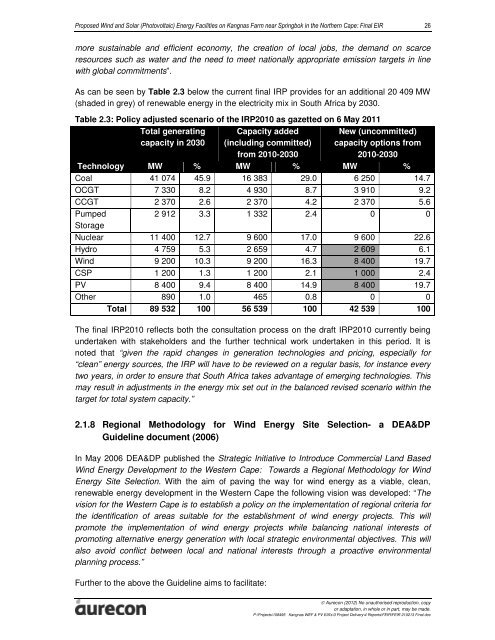
![CRR IV FEIR ~ 26042010 [FINAL].pdf - Environmental Projects](https://img.yumpu.com/21973020/1/184x260/crr-iv-feir-26042010-finalpdf-environmental-projects.jpg?quality=85)
